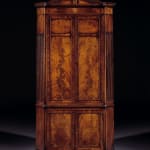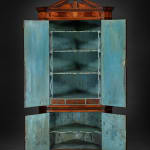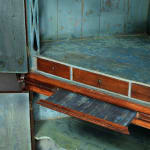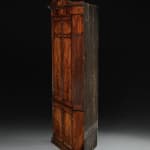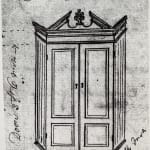WORKS FOR SALE

Gillow design of 1787 for a standing corner cupdoard of the same model as the preset example, illus. Gillow Furniture Designs 1760 - 1800, ed. Lindsay Boynton (1995), fig. 173
A GEORGE III MAHOGANY STANDING CORNER CUPBOARD
W: 41" / 105cm
D: 24" / 62cm
Further images
Provenance
Private Collection: London, UKLiterature
Gillow Furniture Designs 1760 - 1800, ed. Lindsay Boynton (1995), fig. 173
This fine and rare neoclassical mahogany corner cupboard stands out not only for its architectural elegance but also for the exceptional survival of its original blue-painted interior—a particularly rare and evocative feature. The design is conceived in the manner of a miniature classical façade, with fluted pilasters, a dentilled cornice, and a broken pediment framing a central plinth, likely intended to support a bust or urn. The frieze is inlaid with boxwood-strung oval roundels, the central one proudly displaying the Prince of Wales’s feathers—an emblem of patriotic and aristocratic alignment.
The refined proportions and restrained ornamentation evoke the order and balance of the late 18th century’s neoclassical ideals. The doors are outlined with crisply moulded panels, while the front is veneered in beautifully matched flame-figured mahogany, imparting warmth, sophistication, and visual drama. Yet it is the interior, painted in a soft Adam-style blue, that distinguishes this cupboard as something truly special. Such original painted finishes rarely survive, and this particular tone—light, elegant, and ethereal—speaks directly to the late Georgian shift toward interiors that prioritised comfort, luminosity, and refinement.
The shaped interior shelves, linked by delicate Chinese-style trellis work, add a note of charm and whimsy, enhancing the overall feeling of lightness and cheer. Below, the drawers are veneered in a more modest mahogany, revealing the workshop’s practical judgement in reserving the finest, most costly cuts for the visible exterior—an insight into the working methods of an accomplished cabinet-maker.
A closely related design for a standing corner cupboard, featuring a broken pediment, fluted pilasters, and panelled doors, appears in a 1787 drawing by Gillows, one of the most important English furniture-making firms of the 18th/19th century (Gillow Furniture Designs 1760–1800, ed. Lindsay Boynton, 1995, fig. 173).
Corner cupboards of this quality, especially with such a rare survival of the original interior, are exceptionally uncommon. This example embodies the ideals of neoclassicism not only in form but in feeling—refined, light-filled, and intellectually precise.




